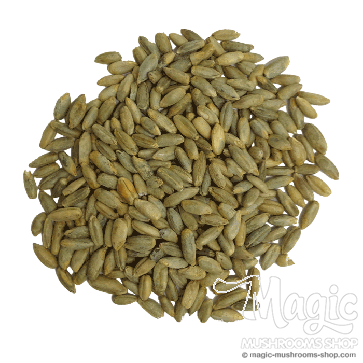Roggen fuhr Pilzsubstrate
Rye Grain is used as part of an ideal mushroom substrate. This rye grain is high quality and 100 % organic.
Organic Rye Berries is available in 1kg.
Verfügbarkeit: Lieferbar
Many species of mushrooms, edible and magic mushrooms love to grow on rye. Make sure that you use the right substrate for your mycelium.
Content
Organic Rye Berries 1kg
Susbtrate and spawn
Rye grain can be used as both a substrate and spawn for mushroom cultivation, and there are some differences between the two.
Spawn is the term used to describe the mycelium that has been grown out on a substrate, such as rye grain. Spawn is used to inoculate the final substrate that the mushrooms will be grown on. This final substrate is typically a mix of different materials, such as vermiculite, coco coir, and gypsum, and is often referred to as the fruiting substrate.
Rye grain is a popular choice for growing spawn for P. cubensis and other mushroom species because it is nutrient-rich and provides a good base for the mycelium to grow on. Rye grain is also relatively easy to work with and can be sterilized and inoculated with spores or a culture of mycelium.
When using rye grain as a substrate, the goal is to create a nutrient-rich environment that will allow the mycelium to grow and spread. The mycelium will consume the nutrients in the rye grain, breaking it down and producing a network of white, thread-like strands called hyphae. Once the mycelium has fully colonized the rye grain, it can be used as spawn to inoculate the final fruiting substrate.
Use
Organic Rye Berries is a popular substrate for P. cubensis and can be used to grow the mycelium that will be used as spawn to inoculate the final fruiting substrate. Here are the basic steps for using rye grain as a substrate for P. cubensis:
-
Prepare the rye grain: Start by thoroughly washing and rinsing the rye grain to remove any debris or dirt. Soak the rye grain in water for several hours or overnight, then drain it and let it air dry until it is slightly damp but not wet.
-
Sterilize the rye grain: Place the rye grain in glass jars or bags and sterilize it in a pressure cooker or autoclave at 15 PSI for at least 90 minutes. This will kill any bacteria or fungi that may be present and prepare the rye grain for inoculation.
-
Inoculate the rye grain: Once the rye grain has cooled, it can be inoculated with P. cubensis spores or a culture of mycelium. Inject the spores or mycelium into the jar or bag using a sterile syringe or pipette, then shake the jar or bag to distribute the spores or mycelium evenly.
-
Incubate the rye grain: Place the inoculated rye grain in a warm, dark place and allow it to incubate until the mycelium has fully colonized the grain. This can take anywhere from a few days to several weeks, depending on the temperature and other environmental factors.
-
Prepare the fruiting substrate: Once the rye grain has fully colonized, it can be used as spawn to inoculate the final fruiting substrate. The fruiting substrate can be a mix of vermiculite, coco coir, and gypsum, or another material that is appropriate for P. cubensis.
-
Monitor the growth: Place the fruiting substrate in a warm, humid environment with proper lighting and ventilation, and monitor the growth of the mycelium and mushrooms. With proper care and attention, you can expect to see P. cubensis mushrooms begin to form within a few weeks.
It's important to note that the use of rye grain as a substrate for P. cubensis is intended for research and development purposes only.
| Artikelnummer | zgn-rg |
|---|---|
| Herkunft | Niederlande |
| Steril | Nein |
Kundenmeinungen
2 Artikel
- Average Kundenmeinung von Frank
-
Always have been using wheat grains before, where the mycelium seems to grow faster than on rye. But it's still working, though. (Veröffentlicht am 15.08.2019)Klassifizierung - Good product. Kundenmeinung von Melgo
-
Good product and good price. Performs well. (Veröffentlicht am 27.05.2019)Klassifizierung
2 Artikel
Nur registrierte Benutzer können Bewertungen abgeben. Bitte, melden Sie zich an oder registrieren Sie sich.













